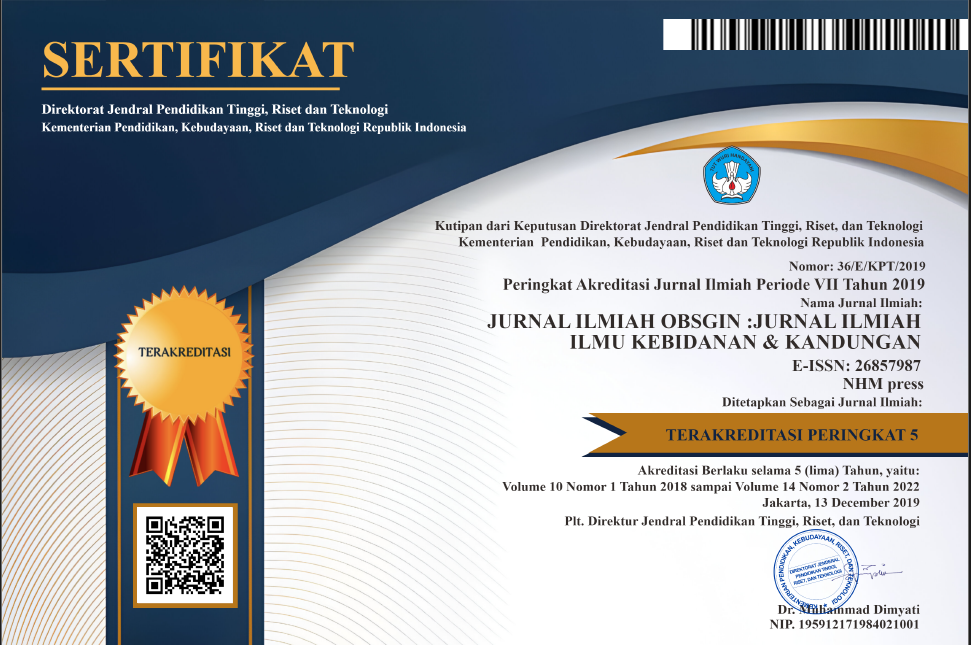EVALUASI KEJADIAN STUNTING PADA BALITA YANG MEMILIKI RIWAYAT DIARE DAN ISPA DI PUSKESMAS RUMBIA
Abstract
Stunting (low length- or height-for-age), in young children is the result of multiple circumstances and determinants, including antenatal, intra-uterine and postnatal malnutrition. Stunting in early life is associated with adverse functional consequences, including poor cognition and educational performance, low adult wages, lost productivity and, when accompanied by excessive weight gain later in childhood. This study aims to determine the risk factors for stunting in toddlers during the Covid 19 period at the Rumbia Health Center.
This study is an analytic observational study using a Case Control Study design with a total sample of 82 (41 cases and 41 controls) using purposive sampling technique. This study involved toddlers aged 6-60 months in Rumbia District, Bombana Regency, which consisted of 4 Kelurahan and 1 Village. Analysis of research data was carried out using an odds ratio at a significant value of 0.05.
Based on bivariate analysis of stunting in children under five, it was found that a history of infectious diarrheal disease with OR = 0.3 (95% CI: 0.1-1.0), acute respiratory tract infection with OR = 0.4 (CI 95 % :0,1-1,6).
Birth weight, family income, mother's education level and infectious diarrheal diseases are factors related to the incidence of stunting in toddlers during the COVID-19 period, while the determinant factor for stunting in toddlers during the COVID-19 period is a history of suffering from diarrhea.
References
Akseer, N., Kandru, G., Keats, E. C., & Bhutta, Z. A. (2020). COVID-19 pandemic and mitigation strategies: implications for maternal and child health and nutrition. The American Journal of Clinical Nutrition, 112(2), 251–256.
Alifariki L, Rangki, L., Haryati, H., Rahmawati, R., Sukurni, S., & Salma, W. O. (2020). Risk Factors of Stunting in Children Age 24-59 Months Old. Media Keperawatan Indonesia, 3(1), 10–16.
Alifariki, L. O. (2020). Gizi Anak dan Stunting. Yogyakarta. Penerbit LeutikaPrio.
Andriani, Z. Z., Salma, W. O., & Akifah, A. (2019). Hubungan Pendidikan Ibu, Status Ekonomi Keluarga Dan Asupan Makanan Dengan Kejadian Stunting Pada Balita Usia 12-59 Bulan di Desa Wawatu Kecamatan Moramo Utara Kabupaten Konawe Selatan. Endemis Journal, 1(2).
Binagwaho, A., Rukundo, A., Powers, S., Donahoe, K. B., Agbonyitor, M., Ngabo, F., Karema, C., Scott, K. W., & Fawzi, M. C. S. (2020). Trends in burden and risk factors associated with childhood stunting in Rwanda from 2000 to 2015: policy and program implications. BMC Public Health, 20(1), 1–9.
Budge, S., Parker, A. H., Hutchings, P. T., & Garbutt, C. (2019). Environmental enteric dysfunction and child stunting. Nutrition Reviews, 77(4), 240–253.
Buisman, L. R., Van de Poel, E., O’Donnell, O., & van Doorslaer, E. K. A. (2019). What explains the fall in child stunting in Sub-Saharan Africa? SSM-Population Health, 8, 100384.
De Onis, M., & Branca, F. (2016). Childhood stunting: a global perspective. Maternal & Child Nutrition, 12, 12–26.
Desyanti, C., & Nindya, T. S. (2017). Hubungan riwayat penyakit diare dan praktik higiene dengan kejadian stunting pada balita usia 24-59 bulan di wilayah kerja Puskesmas Simolawang, Surabaya. Amerta Nutrition, 1(3), 243–251.
Dewey, K. G. (2016). Reducing stunting by improving maternal, infant and young child nutrition in regions such as South Asia: evidence, challenges and opportunities. Maternal & Child Nutrition, 12, 27–38.
Dinas Keseharan Kab.Bombana. (2020). Profil Kesehatan Kabupaten Bombana. Bidang Data dan Informasi Kab/Bombana.
Dinas Kesehatan Provinsi Sulawesi Tenggara. (2020). Profil Kesehatan Propinsi Sulawesi Tenggara. Bidang P2PL Dinas Kesehatan Prov. Sultra.
Habimana, S., & Biracyaza, E. (2019). Risk factors of stunting among children under 5 years of age in the eastern and western provinces of Rwanda: analysis of Rwanda demographic and health survey 2014/2015. Pediatric Health, Medicine and Therapeutics, 10, 115.
Hall, C., Bennett, C., Crookston, B., Dearden, K., Hasan, M., Linehan, M., Syafiq, A., West, S., & West, J. (2018). Maternal knowledge of stunting in rural Indonesia. International Journal of Child Health and Nutrition, 7(4), 139–145.
Headey, D. D., & Palloni, G. (2020). Stunting and wasting among Indian preschoolers have moderate but significant associations with the vegetarian status of their mothers. The Journal of Nutrition, 150(6), 1579–1589.
Himawati, E. H., & Fitria, L. (2020). Hubungan Infeksi Saluran Pernapasan Atas dengan Kejadian Stunting pada Anak Usia di Bawah 5 Tahun di Sampang. Jurnal Kesehatan Masyarakat Indonesia, 15(1), 1–5.
Kemenkes RI. (2018a). Hasil utama RISKESDAS 2018. In Jakarta: Kementerian Kesehatan Badan Penelitian dan Pengembangan Kesehatan.
Kemenkes RI. (2018b). Riset Kesehatan Dasar 2018.
Kusumawati, E., Rahardjo, S., & Sari, H. P. (2016). Upaya perbaikan gizi 1000 hari pertama kehidupan dalam rangka pencegahan stunting balita melalui optimalisasi peran tenaga gizi di Kabupaten Banyumas. Kesmas Indonesia, 8(2), 92–101.
Lawaceng, C., & Rahayu, A. Y. S. (2019). Tantangan Pencegahan Stunting pada Era Adaptasi Baru “New Normal” melalui Pemberdayaan Masyarakat di Kabupaten Pandeglang. Jurnal Kebijakan Kesehatan Indonesia: JKKI, 9(3), 136–146.
Lestari, R. I., Dwi Sarbini, S. S. T., Rakhma, L. R., Gz, S., & Gizi, M. (2016). Faktor Risiko Kejadian Stunted Pada Anak Usia 7-24 Bulan Di Desa Hargarejo, Kecamatan Kokap, Kabupaten Kulon Progo, Yogyakarta. Universitas Muhammadiyah Surakarta.
Mantovani, S. A. S., Ramalho, A. A., Pereira, T. M., Branco, F. L. C. C., Oliart-Guzmán, H., Delfino, B. M., Braña, A. M., Martins, A. C., Filgueira-Júnior, J. A., & Santos, A. P. (2016). Stunting in children under five years old is still a health problem in the Western Brazilian Amazon: a population-based study in Assis Brasil, Acre, Brazil. Ciencia & Saude Coletiva, 21, 2257–2266.
Marni, L. (2020). Dampak kualitas sanitasi lingkungan Terhadap stunting. JURNAL STAMINA, 3(12), 865–872.
Sulastri, D. (2012). Faktor determinan kejadian stunting pada anak usia sekolah di Kecamatan Lubuk Kilangan Kota Padang. Majalah Kedokteran Andalas, 36(1), 39–50.
Syed, S., Manji, K. P., McDonald, C. M., Kisenge, R., Aboud, S., Sudfeld, C., Locks, L., Liu, E., Fawzi, W. W., & Duggan, C. P. (2018). Biomarkers of systemic inflammation and growth in early infancy are associated with stunting in young Tanzanian children. Nutrients, 10(9), 1158.
Titaley, C. R., Ariawan, I., Hapsari, D., Muasyaroh, A., & Dibley, M. J. (2019). Determinants of the stunting of children under two years old in Indonesia: a multilevel analysis of the 2013 Indonesia Basic Health Survey. Nutrients, 11(5), 1106.
Van Stuijvenberg, M. E., Nel, J., Schoeman, S. E., Lombard, C. J., du Plessis, L. M., & Dhansay, M. A. (2015). Low intake of calcium and vitamin D, but not zinc, iron or vitamin A, is associated with stunting in 2-to 5-year-old children. Nutrition, 31(6), 841–846.
Vilcins, D., Sly, P. D., & Jagals, P. (2018). Environmental risk factors associated with child stunting: a systematic review of the literature. Annals of Global Health, 84(4), 551.
Walson, J. L., & Berkley, J. A. (2018). The impact of malnutrition on childhood infections. Current Opinion in Infectious Diseases, 31(3), 231.
West, J., Syafiq, A., Crookston, B., Bennett, C., Hasan, M. R., Dearden, K., Linehan, M., Hall, C., & Torres, S. (2018). Stunting-related knowledge: exploring sources of and factors associated with accessing stunting-related knowledge among mothers in rural Indonesia. Health, 10(09), 1250.
Wicaksono, R. A. (2020). Faktor Risiko Kejadian Stunting pada Anak Berusia 1-60 Bulan dengan Menggunakan Kurva Pertumbuhan Anak Indonesia.
Zottarelli, L. K., Sunil, T. S., & Rajaram, S. (2007). Influence of parental and socioeconomic factors on stunting in children under 5 years in Egypt. EMHJ-Eastern Mediterranean Health Journal, 13 (6), 1330-1342, 2007.











